This post may contain affiliate links. I only recommend products or services that I personally use or trust, promise!

Jjajangmyeon is one of Korea’s most beloved takeout foods, and is especially popular with children. It is a black bean noodle dish that is typically served in Korean-Chinese restaurants, often paired with tangsuyuk (crispy sweet and sour pork) and jjamppong (spicy seafood noodle soup).
Every time I have a bowl of jjajangmyeon, I am instantly taken back to Korea. This is a dish that is extremely nostalgic for me because of all the wonderful memories I have about having it delivered right to our door. The delivery person always traveled by motor bike with large metal containers in tow, delivering jjajangmyeon and also picking up the dirty dishes later in the day.
Jjajangmyeon is a Korean-Chinese dish. It was first introduced in Korea by Chinese immigrants, and evolved over time to suit Korean palates.
Although I wouldn’t consider jjajangmyeon to be a difficult dish to make, I’ve gotten a lot of messages from my followers saying that every recipe they have ever tried just doesn’t taste as good as the restaurants. When I first started making jjajangmyeon at home, I had the same problem. It never tasted quite like I had hoped, but I’ve been recipe testing and can confidently say this one is restaurant quality!
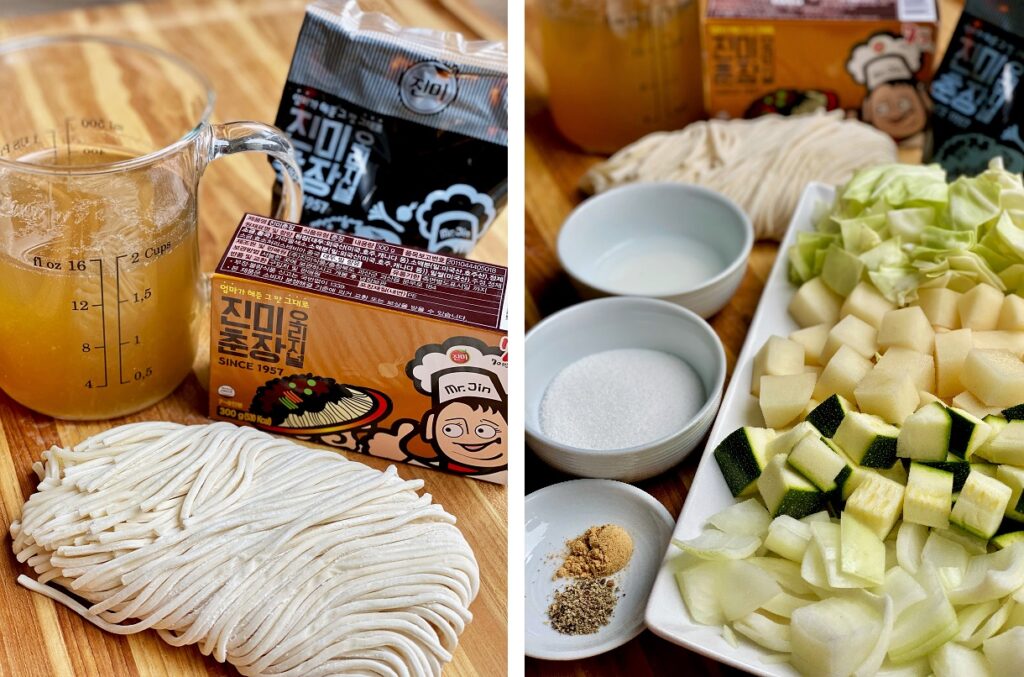
Ingredients
- Black bean paste – I’ve tried a few brands and they are typically the same, but my mom always uses the Jin-mi brand since that’s what is widely used in Korea. Some brands will say their paste is already pre-fried and ready, but I’ve found that this really isn’t the case. No matter what kind you get, don’t skip the frying process for the paste, or it will be bitter.
- Veggies- I use potatoes, cabbage, onions, and zucchini. You can use whatever you like- other common veggies are mushrooms, carrots, and Korean radish.
- Real beef broth- this is my secret to delicious restaurant quality jjajangmyeon. A lot of recipes call for chicken broth but I think beef broth tastes much better. And it has to be REAL beef broth. I make mine using brisket- just lightly season it with some dashida, cover with one cup of water, a couple scallions, garlic cloves, and onions, then slow cook for 3 to 4 hours. Strain the broth to use for the jjajangmyeon, and use the brisket for something else.
- Slurry– use any type of starch to make a slurry for thickening the sauce at the end. How much you use depends on the consistency you like for your sauce. I like a thinner sauce, so I don’t use that much. The amount you use may also differ depending on whether you use potatoes, since those will add some starch to the dish as well.
- Seasoning- not too many additional seasoning except for sugar, black pepper, and ginger powder. I also add a tiny bit of msg and sesame oil at the end, but these are optional.
- Jjajang noodles- I really like the Wang brand for jjajang noodles. They are called Joong-hwa-myeon (중화면). These have a slight yellow color to them which makes me think they are a mixture of egg/wheat noodles. I like noodles that are nice and chewy- these are the best ones in my opinion.
- Pork belly- you can use chicken or beef instead, but I think the best jjajangmyeon is made with pork belly. Pro tip: score your pork belly! This helps the dish in numerous ways. Scoring allows the fat to be rendered out evenly, develops more flavor, and becomes more tender. I usually buy my pork belly already scored from Hmart. If you don’t have that option, just score it by hand at home.
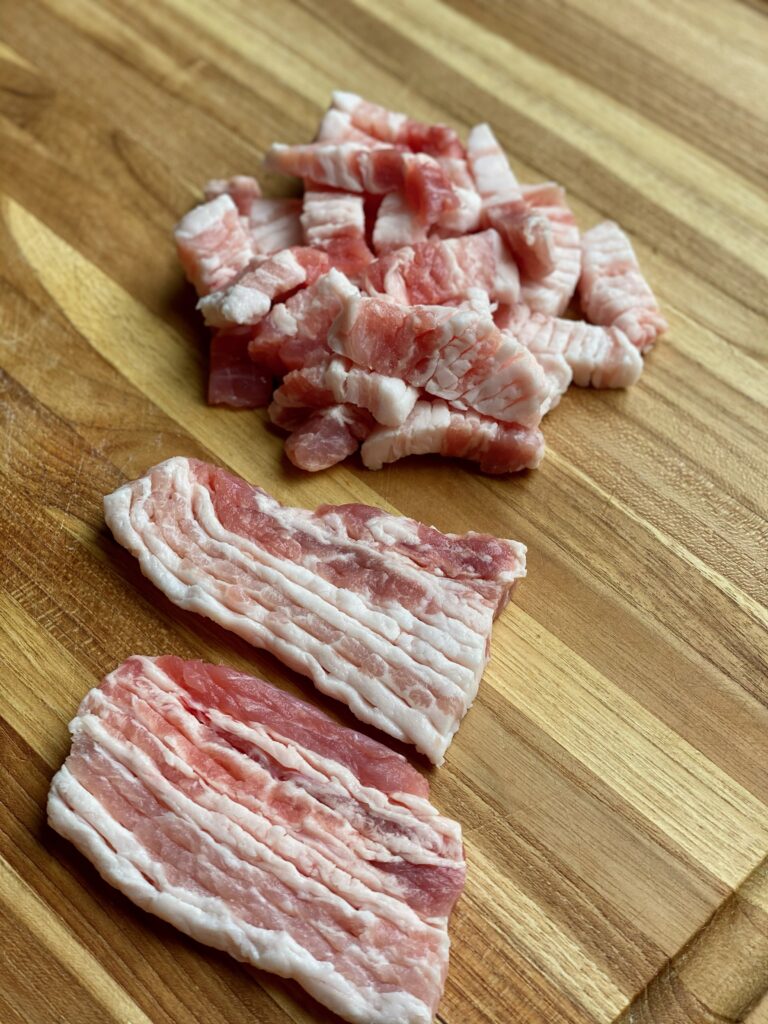
How to enjoy Jajangmyeon
Danmuji (yellow pickled radish) is absolutely mandatory when eating jjajangmyeon! It compliments the dish so well. Jjajangmyeon can be very rich and somewhat heavy, so the danmuji really brightens it up while also adding texture.
Another side/topping that I think is very important is sliced cucumber. It is another element that adds texture and brightens up the dish. I like A LOT of cucumber in my jjajangmyeon- enough for every bite.
If you don’t have noodles or don’t feel like having noodles, try the sauce over the rice! Known as jjajang-bap, this is another common way to enjoy the dish. My dad actually prefers jjajang-bap and asks for it all the time. For jjajang-bap, I think kimchi pairs much better than danmuji. I am currently eating some jjajang-bap with the yu choy kimchi I made with my mom a few weeks ago. It’s so good!

Tips for making restaurant quality jjajangmyeon
- Fry the black bean sauce well! This is the #1 mistake I see people make when preparing jjajangmyeon. The black bean paste has to be fried in a generous amount of oil to really bring out the flavors and get rid of the bitter taste.
- Score your pork belly– As mentioned earlier, this allows the fat to render out evenly, develops more flavor, and makes the pork more tender. You want a good amount of oil (fat) to render out so that we can cook our veggies in it.
- Use REAL beef broth- this really matters. This is the flavor I was missing before I started using it. Chicken broth is fine too, just make sure it is the real, natural stuff. I make my beef broth by slow cooking some brisket that is lightly seasoned with dashida, then covered with 1 cup of water and some aromatics (scallions, garlic, onions).
- Add msg- I’m already knowing this isn’t going to make some people happy, but we all know that restaurants use msg. Did you know that msg is no worse for you than table salt? A little goes a long way, and in moderation it is perfectly safe to consume.
- Cook the noodles for less time than the package instructions- I’m not sure why but I found that the package instructions always tell you to boil the noodles for way too long. I don’t like soft noodles- they need to be chewy and bouncy. I boiled mine for about 3 1/2 minutes and immediately rinsed them under cold water to stop the cooking process.
- The most common question I get about jjajangmyeon is what kind of noodles I use. For some reason, it is difficult to find it online by searching for the name brand (there are two different Wang brand noodles). I have included a picture below for your reference! These are available at Hmart and AR Mart.
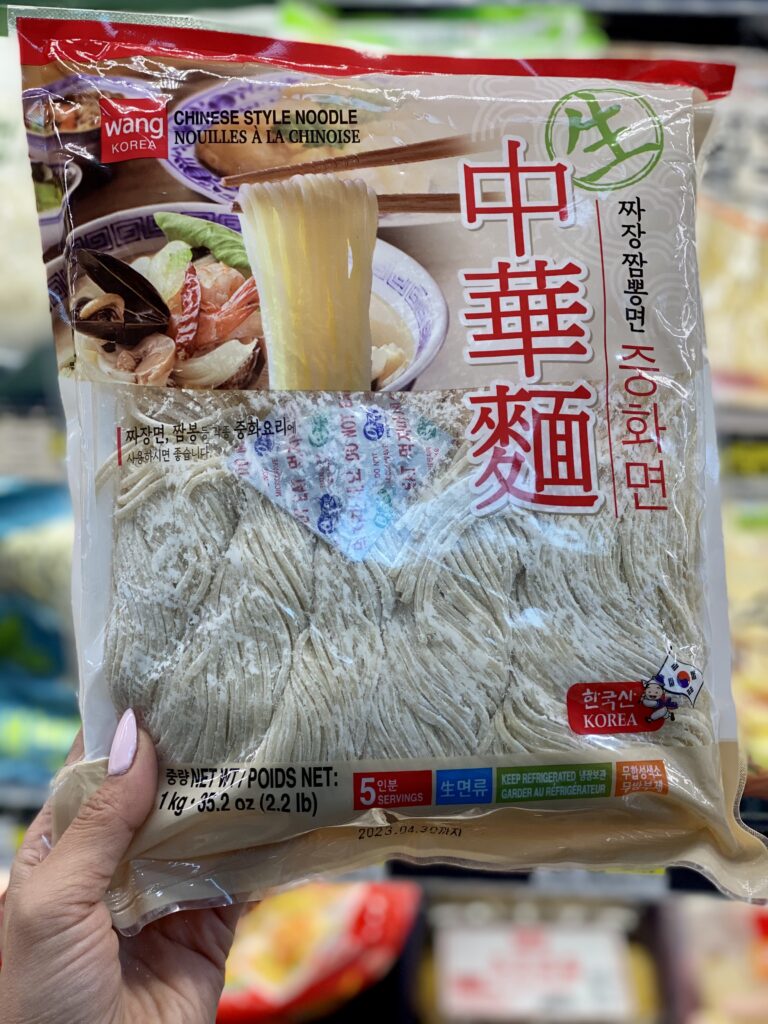
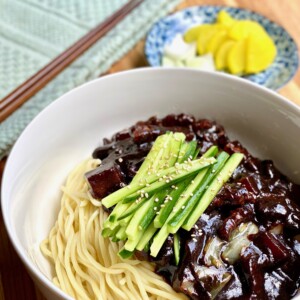
Jjajangmyeon 짜장면- Korean Black Bean Noodles
Ingredients
- 1/2 lb pork belly, scored and thinly sliced
- 1 small onion
- 1/2 cup yukon gold potato
- 1/2 cup zucchini
- 1 cup cabbage
- 3 tbsp oil
- 1/2 cup chunjang (black bean paste)
- 1 to 3 tbsp sugar, see notes on this below
- 1/2 tsp ginger powder
- 1/2 tsp black pepper
- 1 1/2 cups beef broth
- 1/4 tsp msg, optional
- 2 to 3 servings jjajangmyeon noodles, cooked to package instructions, but reduce time by 1-2 minutes.
Slurry
- 2 tsp corn starch
- 2 tbsp water
Garnish
- sesame oil
- sesame seeds
- sliced cucumber
Instructions
- Prepare your veggies by cutting them down into 1/2 inch squares.
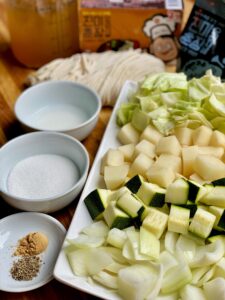
- Score your pork belly then cut them into 1 inch slices. Let them come to room temperature before cooking.
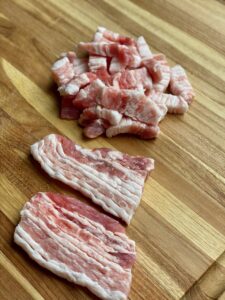
- Bring a non-stick pan to medium heat and cook the pork belly until both sides are lightly browned. There should be a good amount of oil rendered out- leave it.
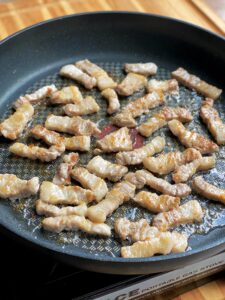
- Add the onions and potatoes. Sauté until onions become translucent, about 2-3 minutes.
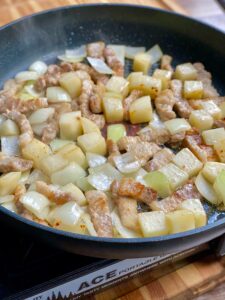
- Add the zucchini and cabbage. Sauté another 2-3 minutes.
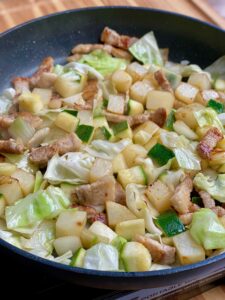
- Make a hole in the center and add 3 tbsp oil. Put the black bean paste on top of the oil and spread evenly. Tilt the pan back and forth to bring more oil to the center, and continue frying the paste in it for about 3 minutes.
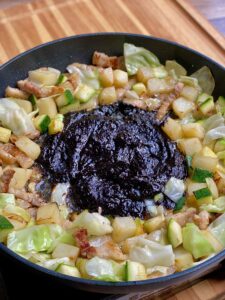
- Mix everything together and continue to fry for another 2-3 minutes, then add the ginger, black pepper, and sugar.Note: If you don't like it too sweet, start with 1 tbsp sugar and gradually add more if needed. I added 3 tbsp to mine- my husband likes it sweet.
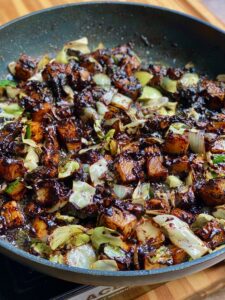
- Add the beef broth and mix until combined. At this point, add the msg if you're using it.
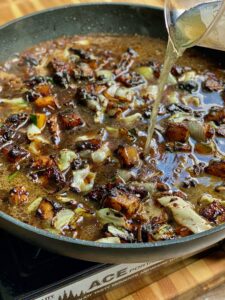
- Add the corn starch slurry and continue mixing until the sauce has almost thickened to your desired consistency. I recommend getting it to a point where it is slightly too thin for your liking- it will thicken even more once you turn off the heat.
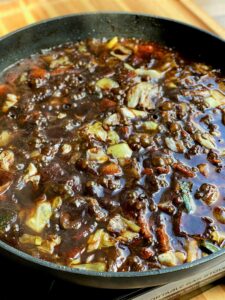
- Ladle the sauce over jjajang noodles or rice. Drizzle over a tiny bit of sesame oil, then garnish with thinly sliced cucumber and sesame seeds. Serve with danmuji (yellow pickled radish).
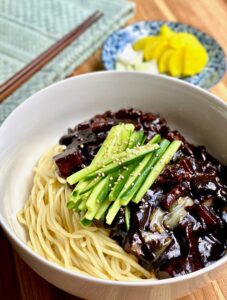
Nutrition information is automatically calculated, so should only be used as an approximation.
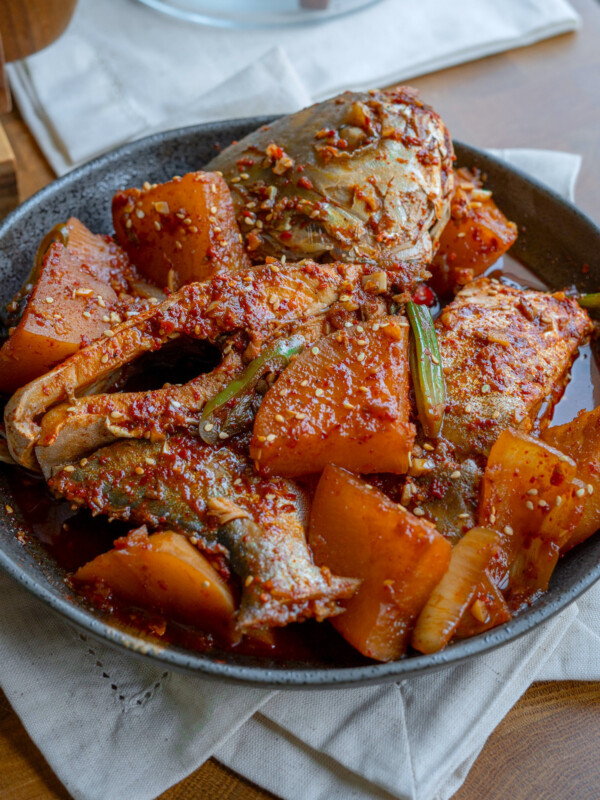
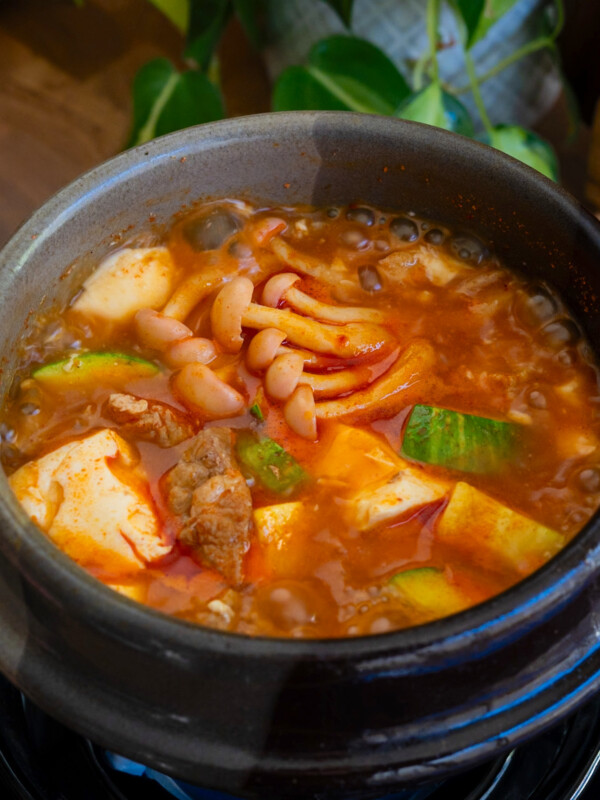
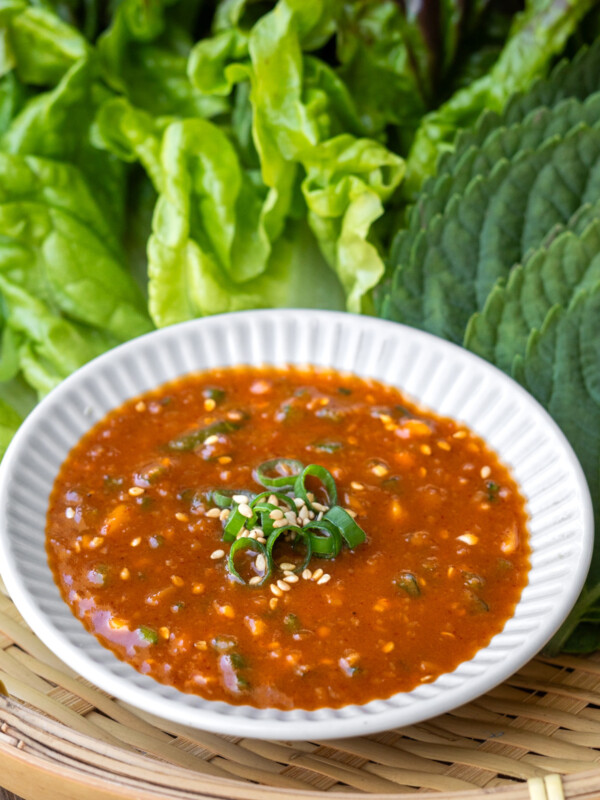
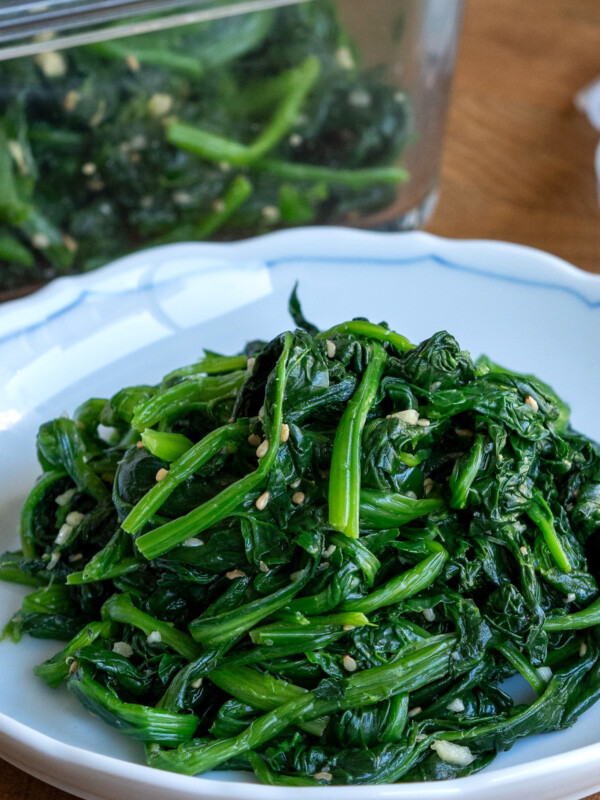







First experience with jjajangmyeon and made it for my Korean roommate’s parents thanks to Stella’s amazing recipe. The thorough explanations and tips for each step practically guarantees success.